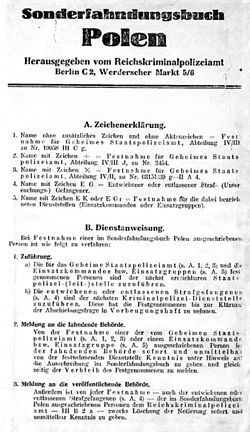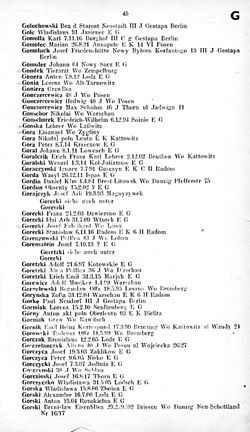Special Prosecution Book-Poland
 Sonderfahndungsbuch Polen. Symbols | |
 Sonderfahndungsbuch Polen. Page with names under the letter "G" with abbreviations. EK
stands for Einsatzkommando and EG represents Einsatzgruppen (a Nazi death squad), meant people to be eliminated by those units. |
Special Prosecution Book-Poland (German: Sonderfahndungsbuch Polen, Polish: Specjalna księga Polaków ściganych listem gończym) was the proscription list prepared by the Germans immediately before the onset of war, that identified more than 61,000 members of Polish elites: activists, intelligentsia, scholars, actors, former officers, and prominent others, who were to be interned or shot on the spot upon their identification following the invasion.
History[]
Nearly two years before the invasion of the Second Polish Republic, between 1937 and 1939, the Sonderfahndungsbuch Polen was being secretly prepared in Germany.[1] It was compiled by the "Zentralstelle IIP Polen" (Central Unit IIP-Poland) unit of the Geheime Staatspolizei or Gestapo ("Secret State Police") with help from some members of the German minority living in pre-war Poland.[2]

The Central Unit IIP-Poland was created by Reinhard Heydrich in order to coordinate the ethnic cleansing of all Poles in "Operation Tannenberg" and the Intelligenzaktion, two codenames for the extermination actions directed at the Polish people during the opening stages of World War II.[3]
Formally, the Intelligenzaktion was a second phase of Operation Tannenberg (Unternehmen Tannenberg) conducted by Heydrich's Sonderreferat. It lasted until January 1940 as the first part of the Generalplan Ost. In Pomerania alone 36,000–42,000 Poles including children were killed already before the end of 1939.[3]
The list identified more than 61,000 members of Polish elite: activists, intelligentsia, scholars, actors, former officers, Polish nobility, Catholic priests, university professors, teachers, doctors, lawyers and even a prominent sportsman who had represented Poland in the Berlin Olympics in 1936. People in the Special Prosecution Book were either killed outright by Einsatzgruppen and Volksdeutscher Selbstschutz or sent to concentration camps to die. The German death squads including Einsatzkommando 16 and EK-Einmann fell under direct command of SS-Sturmbannführer Rudolf Tröger, with overall command by Reinhard Heydrich.[3]
The second and last edition of Sonderfahndungsbuch Polen in German and Polish was published in 1940 in occupied Kraków[4] after the end of AB-Aktion (in German Ausserordentliche Befriedungsaktion).[5] Later lists were published under the name of Fahndungsnachweis. Only a small number of people on the lists managed to survive the German occupation.
See also[]
- Sonderfahndungsliste G.B. ("Special Search List Great Britain"), "The Black Book" of prominent residents of Britain.
References[]
- ^ Stanisław Dąbrowa-Kostka, Hitlerowskie afisze śmierci (eng. "Nazi death posters"), KAW Warszawa 1983, p.339, (Polish),(German),(English)
- ^ Digital version of Sonderfahndungsbuch Polen in Śląska Biblioteka Cyfrowa
- ^ Jump up to: a b c Piotr Semków, IPN Gdańsk (September 2006). "Kolebka (Cradle)" (PDF). IPN Bulletin No. 8–9 (67–68), 152 pages. Warsaw: Institute of National Remembrance. 42–50 (44–51/152 in PDF). ISSN 1641-9561. Retrieved 8 November 2015 – via direct download: 3.44 MB.
- ^ Sonderfahndungsbuch Polen. Ergänzungsnachtrag über entwichene oder vorzeitig entlassene Straf... 1 June 1940, Krakow,
- ^ Stanisław Dąbrowa-Kostka, Hitlerowskie afisze śmierci (eng. "Nazi death posters"), KAW Warszawa 1983, p.92, (Polish),(German),(English)
Bibliography[]
- Sonderfahndungsbuch Polen. Ergänzungsnachtrag über entwichene oder vorzeitig entlassene Straf... 1. Juni 1940, Krakau,
- Andrzej Leszek Szcześniak, Plan zagłady Słowian. Generalplan Ost, Polskie Wydawnictwo Encyklopedyczne PWE, Radom, 2001
- Fritz Arlt: Polen- Ukrainer-Judenpolitik im Generalgouvernement für die besetzten polnischen Gebiete 1939 bis 1940 in Oberschlesien 1941 bis 1943 und im Freiheitskampf der unterdrückten Ostvölker, Lindhorst, Wissenschaftlicher Buchdienst Taege, 1995
- Wacław Długoborski: Zweiter Weltkrieg und sozialer Wandel, Vandenhoeck & Ruprecht, Göttingen 1981, S. 309
External links[]
- Einsatzgruppen
- The Holocaust in Poland
- Historiography of World War II
- Cultural history of World War II
- Holocaust historical documents
- Anti-Polish sentiment in Europe
- Reinhard Heydrich
- Reich Security Main Office
- 1939 documents
- Persecution by Nazi Germany
- Persecution of Poles
- Persecution of Jews
- Persecution of intellectuals